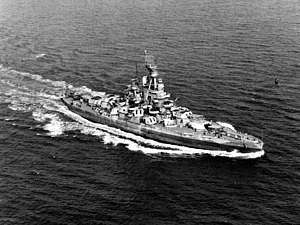
Back USS Nevada (BB-36) AZ Невада (линеен кораб, 1914) Bulgarian USS Nevada (BB-36) Czech USS Nevada (BB-36) German USS Nevada (BB-36) Spanish Nevada (laev 1914) ET یواساس نوادا (بیبی-۳۶) FA USS Nevada (BB-36) Finnish USS Nevada (BB-36) French USS Nevada (skip út 1916) FY
 Nevada underway off the Atlantic coast of the United States on 17 September 1944
| |
| History | |
|---|---|
| Name | USS Nevada |
| Namesake | Nevada[1] |
| Ordered | 4 March 1911[2] |
| Awarded | 22 January 1912[2] |
| Builder | Fore River Shipbuilding Company[2] |
| Laid down | 4 November 1912[1] |
| Launched | 11 July 1914[3] |
| Commissioned | 11 March 1916[1] |
| Decommissioned | 29 August 1946[1] |
| Stricken | 12 August 1948[4] |
| Nickname(s) | "The Cheer Up Ship" |
| Fate | Sunk as a target 31 July 1948, in Operation Crossroads[4] |
| General characteristics | |
| Class and type | Nevada-class battleship |
| Displacement | 27,500 t[5] |
| Length | 583 ft (178 m)[5] |
| Beam | 95 ft 3 in[5] (29 m) |
| Draft | 28 ft 6 in[1][6] (8.7 m) |
| Installed power | |
| Propulsion | |
| Speed | 20.5 kn (24 mph; 38 km/h)[5] |
| Endurance | 8,000 nmi (9,206 mi; 14,816 km) at 10 kn (12 mph; 19 km/h)[8] |
| Complement | 864 officers and men[9] |
| Armament |
|
| Armor | |
| Aircraft carried |
|
| General characteristics 1942 configuration | |
| Displacement | 30,500 t[8] |
| Installed power | 6 Bureau Express oil-fired boilers |
| Complement | 2,220[10] |
| Armament |
|
| Aircraft carried |
|
USS Nevada (BB-36), the third United States Navy ship to be named after the 36th state, was the lead ship of the two Nevada-class battleships. Launched in 1914, Nevada was a leap forward in dreadnought technology; four of her new features would be included on almost every subsequent US battleship: triple gun turrets,[c] oil in place of coal for fuel, geared steam turbines for greater range, and the "all or nothing" armor principle. These features made Nevada, alongside her sister ship Oklahoma, the first US Navy "standard-type" battleships.
Nevada served in both World Wars. During the last few months of World War I, Nevada was based in Bantry Bay, Ireland, to protect supply convoys that were sailing to and from Great Britain. In World War II, she was one of the battleships trapped when the Japanese attacked Pearl Harbor. Nevada was the only battleship to get underway during the attack, making the ship "the only bright spot in an otherwise dismal and depressing morning" for the United States.[11] Still, the ship was hit by one torpedo and at least six bombs while steaming away from Battleship Row, forcing the crew to beach the stricken ship on a coral ledge. The ship continued to flood and eventually slid off the ledge and sank to the harbor floor.[12] Nevada was subsequently salvaged and modernized at Puget Sound Navy Yard, allowing her to serve as a convoy escort in the Atlantic and as a fire-support ship in five amphibious assaults (the invasions of Attu, Normandy, Southern France, Iwo Jima, and Okinawa).
At the end of World War II, the Navy decided that, due to age, Nevada would not be retained as part of the active fleet and she was instead assigned as a target ship for the atomic experiments at Bikini Atoll in July 1946 (Operation Crossroads). The ship was hit by the blast from atomic bomb Able, and was left heavily damaged and radioactive. Unfit for further service, Nevada was decommissioned on 29 August 1946, and sunk for naval gunfire practice on 31 July 1948, in Operation Crossroads.
- ^ a b c d e DANFS Nevada (BB-36).
- ^ a b c d Cox 1916.
- ^ New York Times 12 July 1914.
- ^ a b NVR Nevada (BB 36).
- ^ New York Times 23 October 1915.
- ^ Chisholm 1922, p. 436.
- ^ a b c d e f g h i Friedman 1985, p. 438.
- ^ a b c d Fitzsimons 1978, p. 1982.
- ^ Bonner 1996, p. 101.
- ^ Friedman, Norman (2016). US Battleships – An Illustrated Design History. Annapolis, Maryland: Naval Institute Press. p. 416. ISBN 978-1-59114-247-8.
Cite error: There are <ref group=lower-alpha> tags or {{efn}} templates on this page, but the references will not show without a {{reflist|group=lower-alpha}} template or {{notelist}} template (see the help page).